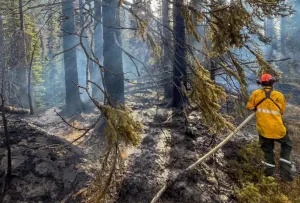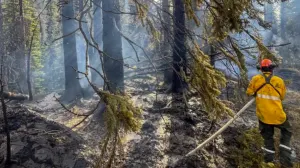
Damaging winds, snow squalls wreak havoc on the Prairies
Damaging winds hit Alberta Tuesday, with a peak gust of 193 km/h recorded at Nakiska Ridgetop.
Ferocious winds and blowing snow wreaked havoc across parts of central and northern Alberta Tuesday evening, with wind warnings expanding into Saskatchewan and Manitoba by Wednesday morning as well.
Downed trees, toppled trucks and widespread power outages were reported in Alberta, as strong gusts between 90 to 120 km/h tore through the region Tuesday.
THE POWER OF THESE DOWNSLOPE WINDSTORMS: UNBELIEVABLE PEAK GUST OF 193 KM/H
Weather Network reporter, Kyle Brittain fought the monster winds atop Olympic Mountain at the Nakiska Ridgetop weather station, which clocked a gust of 193km/h while he was there. That's the strength of an EF2 tornado, and was certainly enough to rip him right off of his feet.
Under certain conditions, air flow can accellerate as it passes over and down a mountain barrier. This is a frequent occurrence in the Alberta Rockies, as strong westerly flow out of the Pacific crosses into the Prairies.
"The strongest of these events can cause downslope windstorms, producing gusts well in excess of 100 km/h, which is exactly what we saw Tuesday," says Weather Network meteorologist Michael Carter. "It's just important to make the distinction between a momentary wind gust and a sustained wind, which is what you would see in a tornado."
The exact shape and contours of the landscape can cause localized areas of even higher wind speeds called "gap winds," where flow is funneled through a gap in the terrain such as a mountain pass, and accellerates even further.

DANGEROUS NIGHT ON THE ROADS WITH RARE ALBERTA SNOW SQUALL WARNING
At one point Tuesday evening, a snow squall warning was also issued in Alberta, catching numerous drivers off guard with the brief, but intense, bursts of heavy snow.
"Snow squalls are one of the most dangerous winter weather conditions, since they can cause very sudden changes in visibility, leading to the rapid onset of whiteout conditions," says Carter, adding that a snow squall coupled with the strong winds that were occurring, can cause road conditions to change from clear and dry to impassable in just moments.
Edmonton Police Service issued a traffic advisory around 8:30 p.m., urging motorists to avoid Calgary Trail between 41st Avenue and 19th Avenue, where three semi-tractor-trailers had toppled over amid the powerful winds and blowing snow.
RCMP also advised drivers to delay travel until conditions improved, with reports of several semi-tractor trailers overturned along the QEII in the Nisku area.
No injuries were reported in the rollovers.
According to Epcor, about 5,000 customers had lost power due to the fierce winds in the Edmonton area Tuesday night, with crews working through the night in attempt to get everyone back online.
STRONG WINDS PUSH EASTWARD WEDNESDAY
The blustery, northwesterly winds gusting from 70-90 km/h pushed into western Saskatchewan Tuesday night, continuing to spread into southwestern Manitoba as they ease across Alberta Wednesday.
Accompanying the winds will be a widespread swath of snow, with just 5-10 cm expected across most areas, but heavier amounts falling to the north. More blowing and drifting snow is possible, likely creating difficult travel through the day Wednesday.

Winds are expected to wind down in Saskatchewan by Wednesday afternoon and Manitoba in the evening hours, as snow tapers off to a few flurries in the both provinces later in the day.
ARCTIC AIR BEGINS TO SINK SOUTH
Winter finally returns to the region this week with an extended period of near to below seasonal temperatures expected starting late this week.
The city of Edmonton, Alberta for example, started the week 10°C above seasonal, and will finish it 10°C below.
POLAR VORTEX UPDATE: Coldest air on Earth sends temperatures below -50°C in Siberia
"We're watching the potential for temperatures to rebound for several days late next week, but colder weather should return again for February," says Weather Network meteorologist Dr. Doug Gillham.
Be sure to check back as we continue to monitor the return of winter conditions across the Prairies.
Thumbnail image courtesy of Cody Prosper/Submitted










